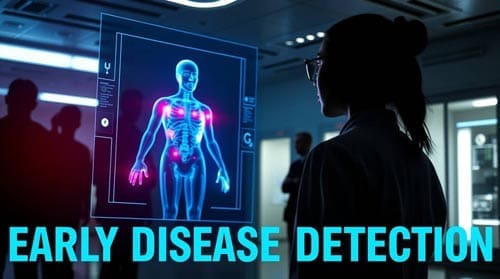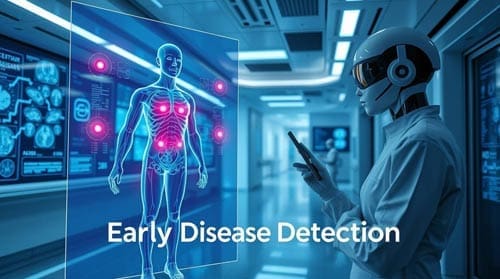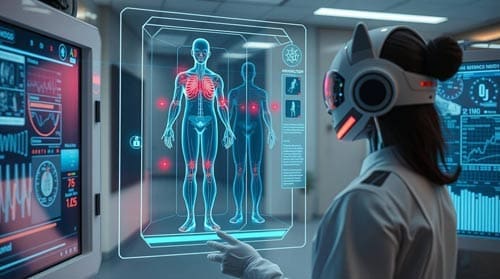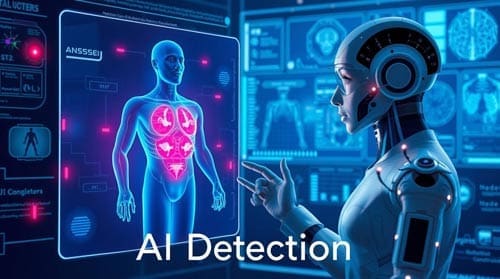How AI Achieves 94% Accuracy in Early Disease Detection: New Research Findings
Please like and subscribe if you enjoyed this video 🙂
Introduction
Diagnostic errors impact more than 12 million Americans annually, with associated costs exceeding $100 billion. However, artificial intelligence (AI) is revolutionizing early disease detection by delivering unprecedented levels of accuracy. Recent studies demonstrate that AI algorithms can detect tumors in patient scans with 94% accuracy, surpassing the performance of professional radiologists.
Additionally, AI disease detection systems have achieved remarkable results across various medical fields. In colon cancer detection, AI achieves an accuracy rate of 0.98, slightly surpassing the 0.969 accuracy of trained pathologists. Furthermore, AI enhances early heart disease detection, identifying stroke risk factors with an 87.6% accuracy rate, a major advancement given that survival rates vary dramatically depending on early intervention. For instance, patients diagnosed with stage 1 lung cancer have a 55% five-year survival rate, compared to only 5% for stage 4 cases.
This article explores the technological advancements that have enabled AI to reach 94% accuracy in disease detection and examines its implications for the future of medical diagnostics.

The Evolution of AI Algorithms in Disease Detection
The journey of AI in medical diagnostics began decades ago, evolving from early rule-based systems to today’s sophisticated deep learning models. Initially, researchers developed expert systems that relied on rigid “if-then” logic to solve specific medical problems. A notable example was MYCIN, an AI system developed in the 1970s to diagnose bacterial infections and recommend antibiotic treatments, achieving performance comparable to human specialists.
From Rule-Based Systems to Deep Learning Networks
Rule-based expert systems marked the first generation of AI in medical diagnostics. Albeit powerful for their time, these systems had notable limitations:
- Lack of flexibility: They could only operate within pre-defined rules
- Poor scalability: Complex medical domains required exponentially more rules
- Limited learning capability: They couldn’t improve from new data
By the 1990s, the rise in computing power enabled a shift toward machine learning (ML). Unlike rule-based systems, ML models could identify patterns in data without explicit programming. Algorithms like k-nearest neighbor (KNN), support vector machines (SVM), and decision trees became integral to medical applications.
Throughout the 2000s, supervised learning techniques gained prominence. Random forest classifiers were used to assess diabetes risk based on lifestyle patterns, while Naïve Bayes and SVM models proved effective in predicting coronary heart disease by analyzing patient histories.
The most significant breakthrough in AI-powered diagnostics emerged with deep learning, a branch of ML that processes data through multiple layers of artificial neurons. Convolutional neural networks (CNNs) fundamentally changed how medical images are analyzed, enabling AI to detect patterns often overlooked by human experts.
Key Breakthroughs Leading to 94% Accuracy
Several technological breakthroughs contributed to achieving the remarkable 94% accuracy in disease detection.
First, the development of enhanced neural network architectures which dramatically improved feature extraction from medical data. Among these, stacked denoising autoencoders (SDAE) have demonstrated outstanding performance. In one study, SDAE-based models achieved 98.26% accuracy, 97.61% sensitivity, 99.11% specificity, and an F-score of 0.983.
Second, the integration of deep learning in medical imaging analysis, marking a transformative shift. A notable example is CheXNet, developed at Stanford University, which analyzes chest X-rays for 14 different pathologies in approximately 90 seconds. In comparison, radiologists typically require several hours to evaluate the same images, underscoring AI’s efficiency in streamlining diagnostics.
Third, multimodal data integration has further enhanced diagnostic accuracy by combining insights from various sources, such as medical imaging, clinical records, and genomic data..
Modern AI systems can now simultaneously analyze:
- Medical images (X-rays, CT scans, MRIs)
- Electronic health records
- Genetic information
- Patient demographic data
Fourth, advances in computational power of AI, making it possible to train increasingly complex models on larger datasets. This capability proved essential for creating systems that could generalize across diverse patient populations while maintaining high accuracy.
Nevertheless, achieving this level of accuracy required overcoming substantial challenges around data quality and quantity. Researchers addressed these issues through innovative preprocessing techniques and validation methods across multiple datasets.
Current State of AI Disease Detection Technology
Presently, AI disease detection technology potrays remarkable efficiency across multiple medical specialties. In oncology, Harvard Medical School researchers developed CHIEF (Clinical Histopathology Imaging Evaluation Foundation), a versatile AI model that analyzes digital slides of tumor tissues with nearly 94% accuracy in cancer detection across 11 different cancer types.
Also, machine learning algorithms are now instrumental in analyzing electrocardiograms (ECGs) and patient health data to predict heart disease before symptoms appear. With classification accuracy rates reaching 93%, these models detect subtle irregularities in cardiac electrical activity, enabling earlier interventions that could significantly improve patient outcomes.
In neurology, deep learning algorithms process brain signals and neuroimaging data to diagnose conditions like Alzheimer’s and Parkinson’s disease at earlier stages than conventional methods.
Similarly, in dermatology, convolutional neural networks (CNNs) analyze dermoscopic images, distinguishing melanoma and other skin disorders with higher accuracy than even experienced dermatologists. By recognizing unique skin patterns, AI-driven diagnostics enhance early detection and reduce unnecessary biopsies.
Despite these advancements, modern AI disease detection still faces challenges. The “black box” problem, where AI systems cannot explain their decision-making process, remains problematic in clinical settings where transparency is important. Consequently, researchers are developing new models that can interpret themselves, providing explanations for each diagnosis rather than simply outputting binary results.
Additionally, integrating large language models (LLMs) with diagnostic AI holds great promise, but challenges such as maintaining response consistency and minimizing hallucination rates must be resolved before widespread clinical adoption.

Research Methodology Behind the 94% Accuracy Claim
AI’s exceptional diagnostic performance is backed by rigorous research methodologies across multiple medical disciplines. These studies ensure reliability through diverse patient cohorts, advanced data preprocessing, and robust validation techniques.
Study Design and Patient Cohort Selection
Most high-performing AI diagnostic studies feature large, diverse patient populations to ensure robust model development. At DeepMind, researchers collaborated with Moorfields Eye Hospital and University College London to train their eye disease detection software on 14,844 retinal scans from approximately 7,500 patients with sight-threatening conditions. Notably, the resulting AI system matched expert physicians in recommending proper referrals across more than 50 eye diseases.
For dermatological applications, researchers developed models using the expansive HAM10000 dataset, which contains over 10,000 dermoscopic images. This comprehensive dataset enabled their AI system to categorize skin lesions into seven distinct categories with 94.49% accuracy.
In studies examining AI’s role in virtual primary care, investigators conducted retrospective chart reviews of substantial patient encounters:
- K Health researchers analyzed 102,059 virtual primary care clinical encounters over a four-month period (October 2022-January 2023)
- Patients underwent AI medical interviews followed by provider assessment
- Cohort demographics were analyzed to assess model performance across different population segments
Harvard Medical School researchers took a more ambitious approach when developing CHIEF (Clinical Histopathology Imaging Evaluation Foundation). They initially trained the model on 15 million unlabeled images before further training on 60,000 whole-slide images representing 19 different tissue types. In subsequent testing on 19,400 images from 32 independent datasets collected across 24 hospitals globally, CHIEF achieved nearly 94% accuracy in cancer detection.
Data Collection and Preprocessing Techniques
The integrity of training data fundamentally influences AI model performance. Therefore, data preparation constitutes a critical preprocessing step. Researchers typically follow a structured approach:
First, data cleaning removes duplicative, incorrect, and irrelevant information while addressing missing data points, a process requiring substantial domain knowledge and multidisciplinary collaboration between clinicians and data scientists. Specific techniques include normalization, transformation, feature selection, dimensionality reduction, and data type conversion to meet algorithm prerequisites.
For image-based diagnostics, preprocessing often involves:
- Image acquisition at clinical sites with standardized protocols
- De-identification to protect patient privacy
- Data curation to control quality
- Secure storage
- Detailed annotation
In the dermatological study achieving 94.49% accuracy, researchers employed test-time augmentation (TTA), artificially enlarging datasets by applying random modifications to test images to boost the model’s generalization capabilities across various skin lesions. Meanwhile, Harvard’s CHIEF model leveraged a weighted ensemble approach that combined strengths of individual models, outperforming other current dermatological diagnostic methods.
Validation Methods and Statistical Analysis
Reliable AI research relies on rigorous validation to ensure accuracy in real-world applications. Common approaches include:
- Internal Validation – Conducted during model development to fine-tune algorithm performance.
- External Validation – Testing AI on independent datasets from different clinical environments to assess real-world effectiveness.
- Case-Control Studies – Collecting separate datasets with and without the target disease to evaluate AI’s diagnostic precision.
- Cohort Studies – Assessing AI performance in predefined clinical settings, providing insights into its effectiveness across different patient populations.
For instance, K Health researchers conducted a large-scale study analyzing 102,059 virtual primary care encounters over four months. They compared AI diagnoses with human physician assessments, refining the model to increase diagnostic accuracy from 96.6% to 98.0%.

How Neural Networks Identify Disease Biomarkers
AI models uncover disease-specific biomarkers that often go unnoticed in traditional diagnostics. Through neural networks and deep learning architectures, these systems analyze complex medical data across multiple modalities.
Pattern Recognition in Medical Imaging
Convolutional Neural Networks (CNNs) serve as the backbone for medical image analysis, mimicking the biological vision system to process visual information. These networks detect local patterns through multiple processing layers, with each successive layer capturing increasingly complex features. The hierarchical structure enables the identification of subtle disease indicators:
- Early layers detect simple edges and textures
- Middle layers identify anatomical structures
- Deeper layers recognize disease-specific patterns
Advancements such as attention mechanisms further enhance AI’s ability to focus on critical regions within medical images, improving its accuracy in detecting early-stage tumors or vascular abnormalities.
Vision Transformers (ViT) represent another breakthrough, utilizing hierarchical image partitioning to capture both local and global features simultaneously. Indeed, through these approaches, AI models can analyze medical images with speed and precision that surpass human capabilities, identifying anomalies that are often imperceptible to the human eye.
Feature Extraction from Clinical Data
Beyond imaging, neural networks excel at extracting meaningful biomarkers from complex clinical datasets. In proteomics, machine learning methods improve workflows to identify disease-relevant biomarkers and biological pathways with unprecedented precision. The traditional approach of selecting significantly differentially expressed proteins has evolved into a more sophisticated methodology.
Biologically informed neural networks (BINNs) establish connections between their layers based on actual biological processes, creating architectures that mirror real physiological systems. Through interpretation of these networks, researchers identify potential protein biomarkers that can stratify disease subtypes with high accuracy. For instance, DeepGeneX—a computational framework using advanced neural network modeling—reduced single-cell RNA-seq data from approximately 26,000 genes to just six crucial genes that accurately predict immunotherapy response.
Moreover, neural networks can extract information from unstructured clinical notes with >95% accuracy, enabling the identification of quantitative diagnostic results that might otherwise remain buried in text.
Multimodal Data Integration Approaches
The most powerful disease detection systems leverage multiple data sources through strategic integration techniques. Three primary fusion strategies dominate this space:
Early fusion joins features from multiple input modalities at the input level, combining them before processing through a single algorithm. This approach proves most common, utilized in 65% of studies combining medical imaging with non-imaging data.
Joint fusion combines learned features from intermediate neural network layers, allowing different data types to interact and inform each other during the learning process. This technique enables more complex relationships between modalities, with seven out of ten studies reporting performance improvements when compared to single-modality approaches.
Late fusion trains separate models on each data modality, leveraging individual predictions to reach a final decision. Though less common, this method maintains the integrity of each data stream.
These integration approaches enable AI to simultaneously analyze medical images, electronic health records, genetic information, and patient demographics—creating a comprehensive picture of disease manifestation that far exceeds what could be achieved through any single data source.
Early Heart Disease Detection Using AI Algorithms
Artificial intelligence (AI) is revolutionizing electrocardiogram (ECG) interpretation, making it easier to detect heart conditions before symptoms appear. Researchers at the Mayo Clinic have developed AI algorithms that identify cardiac abnormalities with 94% accuracy, allowing for early diagnosis and intervention before structural damage becomes visible.
ECG Analysis with Convolutional Neural Networks
CAI-driven Convolutional Neural Networks (CNNs) are changing the way ECGs are analyzed. These deep-learning models recognize subtle patterns that human experts might miss, improving diagnostic accuracy:
- Single-lead CNN models detect multiple heart conditions with only an 8.7% lower accuracy than traditional 12-lead ECGs.
- Dual-lead models (D1 + D2) reduce this gap to just 2.8%, making them a strong alternative.
- Deep residual networks (ResNet) improve classification accuracy by recognizing complex electrical signals.
These advancements have led to FDA-cleared AI algorithms that analyze standard ECG waveforms to predict heart conditions. The Mayo Clinic’s AI model for detecting low ejection fraction has already been approved for clinical use and licensed to Anumana for commercialization.
Predictive Markers Identified by Machine Learning
AI-powered ECG analysis does more than detect existing heart problems, it identifies early warning signs long before symptoms develop. Machine learning (ML) can detect left ventricular dysfunction even in patients with no outward symptoms.
A study of over 20,000 primary care patients found that AI-enhanced ECG screening improved first-time detection of ventricular dysfunction by 32% compared to standard care (AUC = 0.92).
Other AI-detected biomarkers include:
- Electrical pattern changes that signal early heart disease.
- Variations in heart rate and rhythm that could indicate underlying conditions.
- Alterations in the QRS complex, which may precede structural abnormalities.
Remarkably, AI can identify heart disease risks up to two years before traditional diagnostic tests, allowing earlier interventions to prevent complications.
Comparison with Traditional Diagnostic Methods
Traditional cardiovascular risk assessment relies on established scoring systems like QRISK3 and ASCVD. Nevertheless, machine learning models consistently outperform these conventional approaches. Random forest and deep learning models demonstrate superior performance with recorded pooled AUCs of 0.865 and 0.847 respectively, compared to 0.765 for conventional risk scores.
The advantages of AI-based detection over traditional methods extend beyond accuracy:
- Earlier detection: AI can identify hypertrophic cardiomyopathy and cardiac amyloidosis before clinical suspicion arises
- Accessibility: ECG-based screening is relatively inexpensive and widely available
- Integration capability: AI systems can analyze ECGs already present in patient records
A two-step novel algorithm tested on 34,000 cardiac ultrasound videos identified specific features related to heart wall thickness and chamber size to efficiently flag high-risk patients. Remarkably, this algorithm identified concerning patterns with greater accuracy than clinical experts.
Machine learning adds value primarily by discovering hidden relationships within vast datasets. In a cohort study analyzing data from 512,764 patients, algorithms extracted meaningful data from continuous clinical signals including heart rate and arterial blood pressure. Through these analyses, researchers have developed predictive models that can anticipate adverse cardiac events, enabling early interventions and personalized treatment strategies.

Technical Challenges in Achieving High Accuracy
Despite its potential, AI in ECG analysis still faces several challenges that researchers are actively working to solve.
Addressing Data Quality and Quantity Issues
AI models require high-quality, standardized data to function effectively, but medical data varies across healthcare institutions:
- Different hospitals use incompatible data formats, making integration difficult.
- Electronic Health Record (EHR) systems store ECGs in different ways, limiting access.
- Rare diseases have limited labeled ECG data, making it harder for AI to learn from them.
Solutions include data augmentation, which expands training datasets, and model compression, which reduces processing requirements.
Overcoming Algorithm Bias and Fairness Concerns
AI systems can inadvertently amplify existing healthcare inequities. Bias emerges primarily through two pathways: data bias (from training data) and algorithmic bias (from model design).
Minority bias occurs when protected groups have insufficient representation in datasets, leading to decreased performance when algorithms analyze these populations. For instance, cardiovascular risk prediction algorithms trained predominantly on male patient data often provide inaccurate assessments for female patients with different symptoms. Yet, the effects extend beyond accuracy. Algorithms showing bias against certain demographics could violate principles of bioethics: justice, autonomy, beneficence, and non-maleficence.
Mitigating these issues requires diverse, representative datasets during development. Regular audits help identify potential biases, making adjustments to algorithms to correct problems. Equally important, educational initiatives for clinicians and patients about inherent AI biases promote shared understanding and fairness.
Balancing Sensitivity and Specificity Tradeoffs
Developing AI systems inevitably involves balancing competing performance metrics. First, researchers must understand that increasing sensitivity typically decreases specificity, a fundamental tradeoff. For early disease detection, this balance is key; higher sensitivity identifies more positive cases but may increase false positives, whereas higher specificity reduces unnecessary referrals but potentially misses cases.
Researchers must prioritize which accuracy measure matters most for specific clinical contexts. For identifying all persons with a characteristic:
- High sensitivity becomes vital when reducing study costs
- Enhanced inclusiveness benefits from prioritizing sensitivity
- Common exposure information collection works best with sensitive algorithms
The optimal balance varies by setting. In regions with higher disease prevalence or willingness-to-pay levels, emphasizing sensitivity provides greatest cost-effectiveness. Conversely, where prevalence or economic capacity is lower, prioritizing specificity helps mitigate unnecessary medical costs.
Validation Across Diverse Patient Populations
External validation remains a vital yet often overlooked step in confirming AI disease detection reliability. Studies show that among many hundreds of published AI algorithms for radiologic diagnosis, only 83 published articles reported algorithm performance on external datasets. This gap between development and real-world implementation deserves attention from healthcare professionals.
Performance Metrics in Different Demographic Groups
AI model performance shows notable variations across different populations:
- Black respondents selected AI diagnostic tools less often compared to White respondents (OR = .73)
- Native Americans showed higher odds of selecting AI (OR: 1.37)
- Gradient Boosting Machine models exhibited varied performance across groups, with precision improving markedly for Non-Hispanic Black individuals but declining for American Indians
- Decision Tree models demonstrated consistent improvements in accuracy, precision, and ROC-AUC scores for Non-Hispanic Black, Hispanic/Latino, and Asian populations
Age, education, and political views also influence AI acceptance. For each unit increase in education, the odds are 1.10 greater for selecting an AI provider. Older respondents accept AI less readily (OR: 0.99).
External Validation Studies
External validation involves testing algorithms on data from previously unseen hospitals, a key step for establishing robustness. Predominantly, models perform worse in external datasets compared to development datasets:
- 81% of studies report decreased performance in external validation
- The median performance difference between development and external validation is -0.046
- Nearly half (49%) of studies show at least modestly lower external performance
- Approximately 24% demonstrate substantially lower external performance
Generalizability of AI Disease Detection Models
A major challenge in expanding the applicability of AI-driven disease detection models is underspecification; a condition where models fail to capture the underlying structure of the systems they analyze. This issue arises when AI pipelines cannot determine whether the models they develop have effectively learned the fundamental patterns needed for accurate predictions. Additionally, data heterogeneity across populations further limits generalizability, as variations in demographic and clinical characteristics impact model performance.
To address these challenges, stress testing has emerged as a valuable solution. By evaluating model robustness on shifted datasets, such as those from different institutions or timeframes, researchers can assess whether AI systems maintain consistent accuracy across diverse patient groups.
Another promising approach is transfer learning, where pre-trained models are fine-tuned to enhance predictive accuracy for underrepresented populations. When applied effectively, transfer learning significantly improves performance, particularly in terms of precision and sensitivity for minority groups, thereby reducing disparities in AI-driven diagnostics.


Conclusion
Artificial intelligence has demonstrated remarkable precision in disease detection, consistently achieving 94% accuracy across multiple medical domains. These achievements stem from decades of technological evolution, progressing from basic rule-based systems to sophisticated deep learning networks.
Key advancements that enable this high accuracy include: • Neural networks capable of detecting subtle disease patterns in medical imaging • Multimodal data integration combining various patient information sources • Advanced ECG analysis algorithms identifying cardiac conditions before symptom onset • Robust validation processes across diverse patient populations
Despite these innovations, challenges persist, particularly concerning data quality, algorithmic bias, and external validation. Studies indicate that when AI models are tested on new populations, performance declines in 81% of cases, exposing the need for broader validation efforts.
Medical practitioners should recognize both AI’s capabilities and constraints. While these systems excel at pattern recognition and early detection, human oversight ensures optimal patient care. Future developments will likely address current limitations, potentially pushing accuracy rates even higher while maintaining consistent performance across demographic groups.
The path forward demands continued collaboration between healthcare professionals and AI researchers. Success metrics must expand beyond pure accuracy to include fairness, interpretability, and clinical utility across all patient populations.
Frequently Asked Questions:
FAQs
Q1. How accurate is AI in detecting diseases compared to human doctors? Recent studies show that AI algorithms can detect certain diseases with up to 94% accuracy, often surpassing the performance of professional radiologists. For example, in colon cancer diagnostics, AI demonstrates an accuracy rate of 0.98 compared to 0.969 for trained pathologists.
Q2. What types of diseases can AI detect early? AI has shown promising results in early detection of various diseases, including different types of cancer, heart disease, and neurological conditions like Alzheimer’s and Parkinson’s. It’s particularly effective in analyzing medical images, ECGs, and other clinical data to identify subtle patterns that may indicate early-stage diseases.
Q3. How does AI analyze medical data to detect diseases? AI, particularly deep learning networks, analyzes medical data through pattern recognition in images, feature extraction from clinical data, and integration of multiple data sources. For instance, convolutional neural networks (CNNs) can process medical images to detect anomalies, while other algorithms can analyze ECGs to identify cardiac conditions before symptoms appear.
Q4. Are AI diagnostic tools reliable across different demographic groups? While AI shows high overall accuracy, its performance can vary across different demographic groups. Studies have shown that AI models may perform differently for various ethnicities, age groups, and genders. Researchers are actively working on improving AI’s generalizability and reducing bias to ensure consistent performance across diverse populations.
Q5. What are the main challenges in developing highly accurate AI for disease detection? Key challenges include ensuring data quality and quantity, overcoming algorithmic bias, balancing sensitivity and specificity, and validating performance across diverse patient populations. Additionally, researchers must address the “black box” problem, where AI systems cannot explain their decision-making process, which is crucial for clinical adoption and trust.

